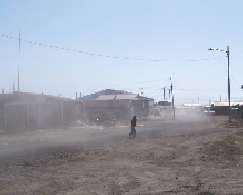Particulate Matter - Health Impacts
There are anecdotal and some peer reviewed studies suggesting more respiratory problems in Alaska 's villages than expected. The causes for this are varied and hard to pinpoint. On the other hand, Alaska is committed to reducing pollutant levels when possible. The opportunity to reduce particulate matter levels is now upon us.
Coarse and fine particulate cause health problems when people are exposed to harmful concentrations. Fine particulate (PM2.5) is associated with more severe health consequences than coarse particulate (PM10). In addition, particulate matter is a nuisance, especially dust. Particulates can settle on furniture, a coffee cup, or subsistence foods, making food inedible, and damaging electronics. Controlling particulate matter will benefit our health and enhance our quality of life.
PM10 - Coarse Particulate (Dust)

(Photo by D. Haggstrom, ADF&G)
EPA health research tells us that dust, measured as PM10, can cause health problems. People with heart disease, those with existing breathing problems (like asthma), children and the elderly are more susceptible to dust than others. These problems include:
- short term airway irritation;
- aggravation of existing heart disease;
- aggravation of existing lung disease (like asthma); and
- damage to lung tissue
PM2.5 - Fine particulate (Smoke / Exhaust)

(Photo by D. Haggstrom, ADF&G)
Numerous scientific studies have linked fine particle pollution exposure to a variety of problems, including:
- increased respiratory symptoms, such as irritation of the airways, coughing, or difficulty breathing;
- decreased lung function;
- aggravated asthma;
- development of chronic bronchitis;
- irregular heartbeat;
- nonfatal heart attacks; and
- premature death in people with heart or lung disease
The links below further detail particulate matter and its affect on human health:

 Indicates an external site.
Indicates an external site.